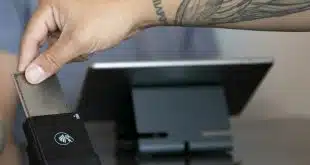By John Stewart
Top executives in the acquiring business are accustomed to looking far into the future, but one near-term concern popped up repeatedly at this week’s Strategic Leadership conference in Scottsdale, Ariz.: How will merchants react when they get their first statements showing chargebacks for counterfeit card fraud?
As of Oct. 1, merchants that cannot process EMV chip transactions are responsible for these fraud losses when a chip card is tendered. Historically, the fraud has been borne by issuers. The first statements indicating these chargebacks ought to be hitting merchant mailboxes around Dec. 1.
Executives on several panels at the conference, which was sponsored by the Electronic Transactions Association, addressed the issue with varying degrees of concern.
Mike Passilla, chief executive of merchant services at JPMorgan Chase & Co., said Wednesday night that acquirers should prepare their call centers for a dramatic jump in volume. “You need to expect a spike in calls for a period of time,” he warned the audience. “Not for a month or two months, but for a good six months.”
Fellow panelist Debra Rossi, an executive vice president at Wells Fargo & Co., historically a major sponsor for independent sales organizations, agreed. “Customers are going to call in, it’s going to happen,” she said.
But the following morning panelists were somewhat more relaxed about the matter. Princeton, N.J.-based Heartland Payment Systems chief executive Robert O. Carr, for example, pointed out that merchants shouldn’t be surprised by their statements, since many acquirers are, or should be, alerting them about chargebacks. “You don’t have to wait for the statement to come,” he said. “We all notify our merchants in advance when chargebacks come through.”
In the first two weeks since the liability-shift date for Visa Inc. and MasterCard Inc., “we’ve not seen a flood of chargebacks come through,” Carr added. Heartland merchants tend to be concentrated in the restaurant, petroleum, and education industries. Under the two network rules, petroleum merchants have another two years before their liability shift.
At the same time, it may well turn out that fraud will be confined to a relatively small pool of merchants. Indeed, Visa has found that 92% of counterfeit fraud losses are concentrated among some 500 merchants, according to Stephanie Ericksen, vice president for global risk products at the network, who served on an earlier panel Thursday.
“We’ve been doing a lot of counseling over the past year with the merchants that have that liability,” she noted. “Yes, there may be some surprises when those statements come.”
Efforts at counseling and education will help, she said, but added that even in cases where merchants are unpleasantly surprised, their reaction may well lead to more EMV terminals going into place. “As those chargebacks come in, there will be more interest in upgrading [to EMV] and adoption will speed up,” she said.
More than 450,000 merchant locations were performing chip transactions as of the end of last month, according to figures presented by Carolyn Balfany, group head for U.S. product delivery at MasterCard Inc. Of these locations, some 400,000 belong to so-called non-aggregated merchants, or retailers with either a single store or only a few locations. “I’d say that’s great progress,” said Balfany, who served on the same panel as Ericksen.
EMV cards are considered extremely hard to counterfeit, both because of the chip and because they generate a one-time cryptogram for each transaction. But for the time being, most chip cards are being issued with magnetic stripes so they can be used at terminals that can’t process chips.





